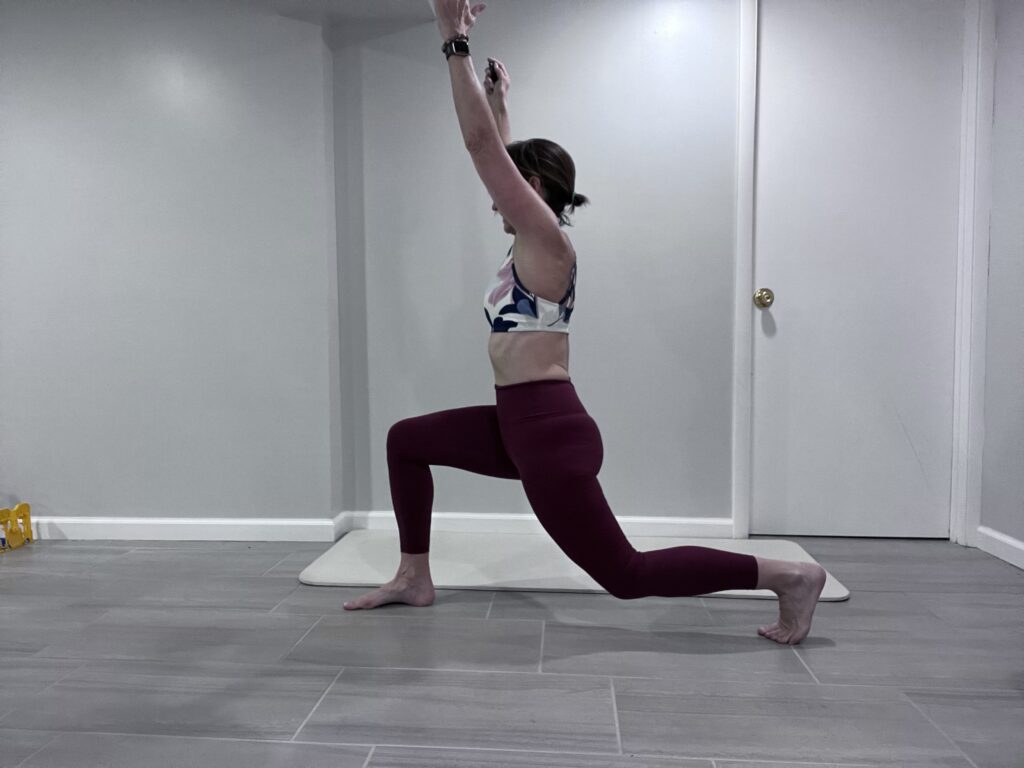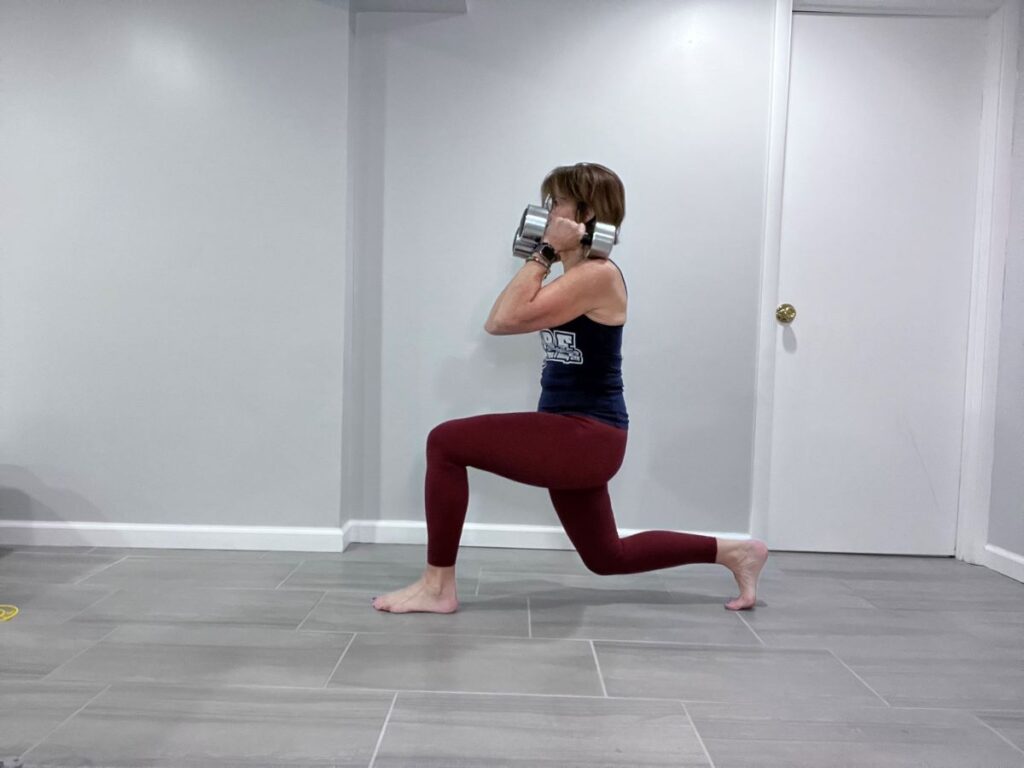Want To Do Lunges After Knee Replacement? Let’s Get Started!
Updated 7/13/24
Is a knee replacement surgery on your calendar, or are you on the recovery side of a knee arthroplasty?
Are you worried about returning to your fitness routine?
I totally get it!
I was just itching to get back to my weight room again, but like you, I was worried that I wouldn’t be able to get back to some of my favorite lower-body exercises like lunges after surgery.
Well, let me tell you, not only are lunges doable after a total knee replacement, but they can also be one of the best exercises for getting your strength and full range of motion back.
In this article, we’ll dive deep into the pros and cons of including lunges in your routine after surgery.
I’ll also share my personal experience and how lunges were slowly reintroduced during and after my physical therapy program.
Just remember that everyone’s recovery journey is different, so just use this as a guide and not as the only way to do it.
You be you and use your own individual approach.

Why Lunges Are Important After Total Knee Replacement
After your total knee replacement surgery, it will be extremely important for you to do exercises that help strengthen the muscles around that beautiful new knee joint.
Getting muscle strength back in your legs after surgery will help with balance and flexibility – which, trust me, will suck right after surgery.
It will be the most important part of recovery.
Can you guess what exercise is highly recommended for strengthening these muscles and keeping your knee in good alignment?
Yep, you guessed it, it’s lunges!
Lunges are an excellent exercise for strengthening the quad muscles (front of the thigh), hamstrings (back of the thighs), and glutes (AKA booty).
My Experience With Returning To Lunges
Remember, this is my experience; yours may look a little different than mine.
You may move faster or slower than me – you do you!
For the first 2-3 weeks, I worked on exercises that helped me get my range of motion back and used both legs together, like wall squats and leg presses in physical therapy.
Then, around 3 weeks post-op, my physical therapist started including unilateral exercises like lunges in my exercise program.
And let me tell you, they were not a pretty sight and just sucked!
The knee pain and weakness limited how much I could bend my leg.
So I started with just a slight bend in the affected leg, and I had to hold on to the wall for support.
For me, backward lunges with just my body weight were easier at first vs. forward lunges.
I focused on practicing lunges every single day because I felt that they would be the gateway to improving my strength and getting back to my regular workouts and everyday activities.
Around the 3-month mark, I was finally able to do forward lunges with light weights and get to a 90-degree angle with good form and less discomfort.
I was also able to do bodyweight curtsy lunges.
They were a bit more challenging since they throw off your center of gravity and can cause you to twist the knee.
Fast forward to 6 months post-op, and I had made a full recovery and I was rocking it!
I was able to hold 15-20 pound weights in each hand while doing forward and backward lunges.
I also started doing weighted lateral (side) lunges and weighted curtsy lunges.
READ MORE: Side Leg Exercises: Benefits And How To Tips For Seniors | Simply Aging Healthy

Step-by-Step Guide for Doing Lunges
When doing lunges after a knee replacement, good form is key to avoid injury and get the most benefit.
It might not be a bad idea to stand next to something like a wall or chair that you can hold onto if your strength is still not up to par.
The following exercises are different ways to do lunges when you’re ready:
Forward and Reverse Lunges:
One of the best exercises that you will do in early recovery is the forward or backward lunge.
To do this:
- Stand with your feet shoulder-width apart and your hands on your hips or at your sides.
- Take a large step forward or backward with your right foot.
- Keep your foot in line with the left foot but not directly behind it.
- Pull your abs in and keep the core tight.
- Bend your front knee – make sure that your front knee is directly above your ankle as you bend the leg. This is very important.
- Lower your body until your back knee almost touches the ground.
- Most of your weight should be on your front leg.
- Make sure that your back is straight and tall with a slight lean forward.
- Push off your back foot and return to the starting position.
- Repeat with your opposite foot.
Lateral (Side) Lunges:
Once you master the forward and backward lunges, it’s time to move on to lateral lunges.
To do this exercise:
- Start in a standing position with your feet hip-width apart and toes forward.
- Place your hands on your hips unless you are using weights.
- Shift your weight to one (right) foot and step to your right—be sure not to step too far.
- Bend your right knee with your back flat and your hips back.
- Keep your knee aligned with your foot, not outside the foot—this could put too much pressure on your new knee.
- Keep the left leg straight, and your toes pointed forward.
- Push into your right foot to return to the starting position.
- Repeat on the other foot.
- You can also do a set of 10-12 on one leg and then switch to the other leg – your choice!
Once you feel strong and comfortable doing side lunges – try grabbing a weight and holding it in front of your chest or down by the floor.
Curtsy Lunge
My therapist advised me not to do curtsy lunges to early in the recovery because it can cause too much twisting of the affected knee.
For the best results, wait until your orthopedic surgeon clears you to do some twisting of the knee. For me, this was around the 3-month post-op mark.
Curtsy lunges are a great way to work that booty!
Here’s how to do them:
- Stand with your feet hip-width apart, hands on your hips, or in front of your chest.
- Pull your shoulders back and engage your core.
- Take one big step back with your left leg, crossing it behind your right leg.
- Slowly bend your knee and lower down until the right thigh is parallel to the floor.
- Both legs should be bent at 90 degrees.
- Push through your right heel to rise out of the lunge.
- Bring your left foot back to hip distance with the right foot.
- Repeat with your same foot or alternate legs – your choice.
Common Mistakes to Avoid
When returning to lunges after total knee replacement, you can make several mistakes which can cause injury or take away the benefit of the exercise.
Here are some common mistakes to avoid:
- Don’t let your knee extend past your toes when stepping forward.
- Don’t let your knee collapse in or out when lowering your body.
- Don’t let your back arch or round during the exercise.
- Don’t rush the exercise; do each lunge slowly and with control.
Signs to Watch Out for During Exercise
Even if your doctor or physical therapist has cleared you to do lunges after total knee replacement surgery, you still need to listen to your body.
If you experience any of the following issues while doing these exercises, you may want to stop and contact your healthcare provider.
Better safe than sorry:
- Sharp or shooting pain in the knee joint
- Swelling in the knee joint
- Becomes hard to put weight on the affected leg
- Instability or weakness in the knee joint
Remember, it is important to start slow and gradually build up your strength and endurance after total knee replacement surgery.
If you experience any pain or discomfort during exercise, it is best to stop and rest.
Don’t worry with some patience, you will be rocking those lunges in no time!
READ MORE: Best Modified Lunges For Seniors: Easy Exercises To Stay Active | Simply Aging Healthy
Yes, You Can Do Lunges after Knee Replacement
After a total knee replacement, you just want to ditch any assistive devices like that old lady walker and crutches.
An excellent way to do that is by doing strength exercises like lunges to get the muscles of your operated leg stronger.
But, it is very important to do lunges with proper form to avoid injury.
So, when you graduate from the heel slides and the leg lifts give lunges a try.
It is important to start with low-impact exercises before going all out with increasing intensity and resistance so that you don’t overwork that new knee of yours.
As you get stronger be sure to add other exercises like squats, step-ups, and leg presses into your strength training routine. They all work differently to improve your knee strength and function.
Don’t be afraid to ask questions when you talk to your physical therapist or orthopedic surgeon – knowledge is power baby!!
If you are struggling, you could think about finding a good trainer to work with for a few weeks or months.
Let me know how your recovery is going. Hopefully, you will be back up and running (well, probably not running) and stronger than ever in no time!
